#George Frese
Text
Shoot to Chill, My Number One Gal


Getting hit by a truck is something more duplicatable than being shot out of a cannon -- there maybe a sign that an Evel Knievel has made it big. Swell is gone, but dig stays.

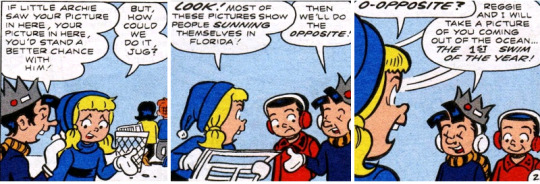
Little Reggie is not angling for Veronica as big Reggie is. I do not know this newspaper habit -- I do suppose the "polar bear swim" gets a photograph in community newspapers. Curious such is dropped from the Little Archie version as I just don't know the great Florida sunbather photo splashes. And what is the newspaper taking in kids' photographs of themselves doing ill-advised activities?


And now to laugh at the casual cruelty of Jugheads and Reggies. The bracket lines are hallmarks of the reprint and almost certainly are not in the initial publication. Interesting to note the icicle Betty change, an icicle character a recurting feature, not as yet codified in the first one. Might lay it as sexist but Icicle Archies do show up over the years.

Pneumonia too much now? It is a pretty provincial news item.
#Archie Comics#Archie Andrews#Betty Cooper#Veronica Lodge#Jughead#Reggie Mantle#Little Archie#Photography#Polar Bear Swim#Newspaper#Icicle#George Frese#1955#Dexter Taylor
14 notes
·
View notes
Text
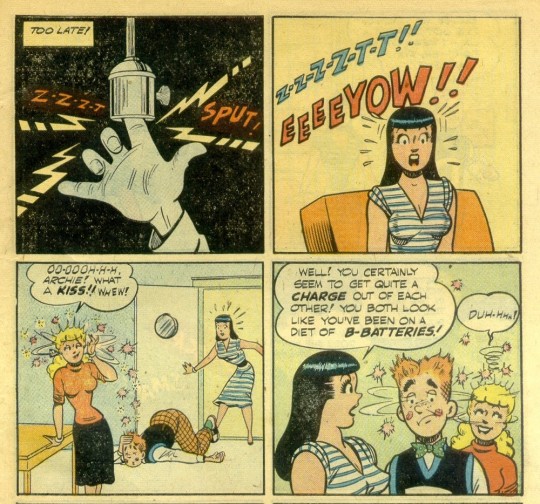
Archie #54: Kiss Me Again
by ?; George Frese (P/I)
Archie Comics
15 notes
·
View notes
Text


Varchie in Archie’s Girls Betty and Veronica #2, 1950 ♥️
#veronica lodge#archie andrews#varchie#varchie comics#archie comics#archies girls betty and veronica#george frese#via: undercover archie#queute as a button ears
80 notes
·
View notes
Photo
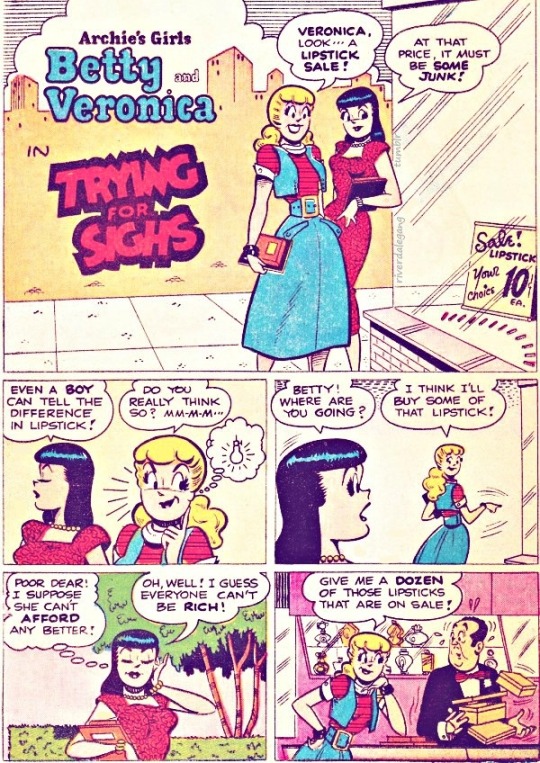

August 1956. Laugh Comics, Issue #76
#Archie Comics#Betty and Veronica#Archie Andrews#smacksandsmooches#riverdalegang#2 page story#George Frese#1950s#BettyandVeronica#riverdalegangstory
173 notes
·
View notes
Text


Original George Frese / Terry Szenics art for a page from Archie's Girls Betty and Veronica #18 (Archie, 1955).
18 notes
·
View notes
Photo

January 1954
#Betty and Veronica#comic#1954#Annual#comic book#George Frese#art#comic cover#1950s#vintage#Archie#comics
75 notes
·
View notes
Photo

PEP Comics #99 - Sept. 1953.
Cover art by George Frese.
rebuilt & restored
#pep comics#archie andrews#veronica lodge#jughead#reggie mantle#betty cooper#riverdale#comics#magazine covers#george frese#illustration#graphic design#jazz noise here#pop culture
24 notes
·
View notes
Text

Laugh Comics #76, August 1956, cover by George Frese
16 notes
·
View notes
Photo
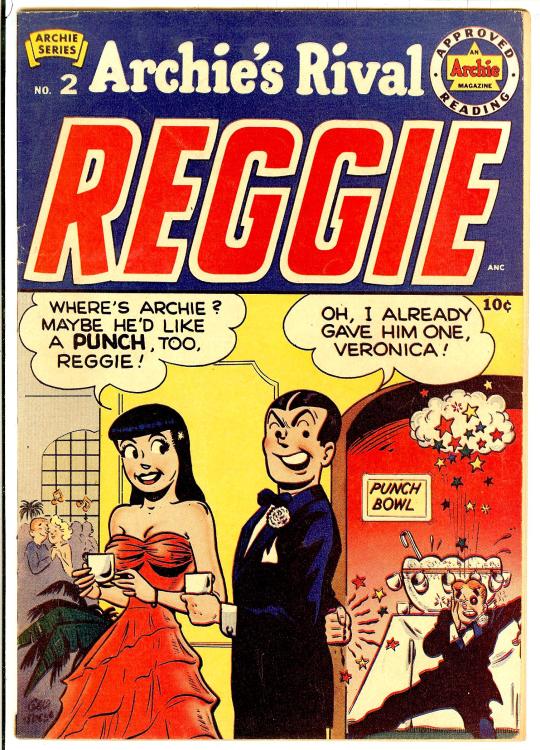
Vintage Comic - Archie’s Rival Reggie #02
Pencils: George Frese
Inks: George Frese
Archie (1950)
#Vintage#Art#Illustration#Design#Comics#Archie#Archie Comics#Archie's Rival Reggie#Reggie#Humor#Humor Comics#Teen Humor#Teen Humor Comics#Veronica#George Frese#1950#1950s#50s
49 notes
·
View notes
Text
Preview: Archie Comics 80th Anniversary Presents Archie
Archie Comics 80th Anniversary Presents Archie preview. Watch as everyone's favorite red-headed teen gets into hijinks and hilarity with his best friends. This issue is full of lighthearted fun stories for everyone! #comics #comicbooks #digitalcomics
ARCHIE COMICS 80th ANNIVERSARY PRESENTS ARCHIE
Script: Various
Art: Various
Cover: George Frese
On Sale Date: 4/22
$1.99
Purchase
Our inaugural issue stars the one and only Archie Andrews himself! Watch as everyone’s favorite red-headed teen gets into hijinks and hilarity with his best friends. This issue is full of lighthearted fun stories for everyone!


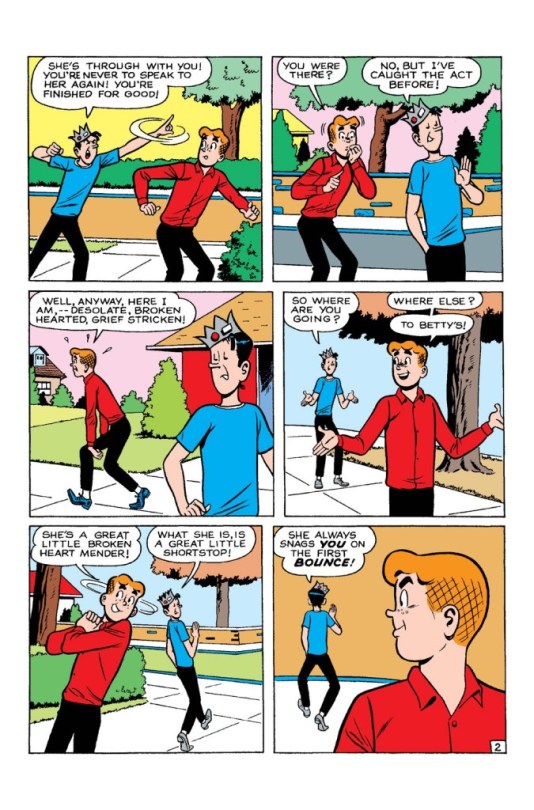




View On WordPress
#archie comics#archie comics 80th anniversary presents#archie comics 80th anniversary presents archie#digital comics#george frese
0 notes
Photo

George Frese art
Veronica, Reggie and Betty
15 notes
·
View notes
Text
introducing the Little Archies

This is very close to being concurrent with the first appearance of The Archies proper, or the initial Archies as strained surreal Monkees take-off, not the Archies we came to know with a Monkees cast-off song as biggest hit single of 1969. Interestingly, Betty is a part of the group here. The next issue of Little Archie would drop back to the trio of Little Archie, Jughead, and Reggie and notably in the red vaudevillian outfit of their big counterparts. Dilton would get a stint playing for the Little Archies before Little Betty and Veronica come on, with them relegated to a stint of little go-go dancing alongside a monkey in the meantime. I suspect an editorial edict from on high -- "Okay, Dexter Taylor. The Little Archies. Go!" -- and an initial lack of coordination. Or, he would have to do a course correction after the first Archies come out, though not fully into that premise. On why Betty needed to be here, it was necessary for plot purposes as they recycled a premise done twice before getting at a visual gag deployed even before that (everyone take the stage as Jughead!)


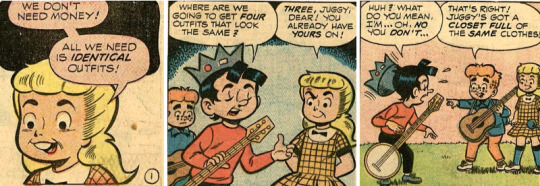
The role of Mr. Weatherbee is taken over by Pop Tate.
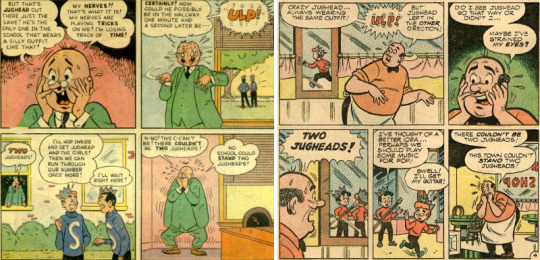
one fish, two fish, red fish, blue fish.

Note one change in reaction between Weatherbee and Pop Tate -- the nuthouse dropped in favour of retiring to tropical island. No allusion to violence.

To be fair, Betty would be selected to be a part of The Archies before Veronica at least in one story, so on that score The Little Archies accidentally forecasts The Archies proper.
#Archie Comics#Little Archie#The Little Archies#Archie Andrews#Betty Cooper#Reggie Mantle#Jughead#Veronica Lodge#Mr. Weatherbee#Pop Tate#Dexter Taylor#1967#George Frese#Bill Vigoda#1959#1951
6 notes
·
View notes
Text



Laugh Comics #76: Trying for Sighs
by Frank Doyle and George Frese
Cover by George Frese
Archie
17 notes
·
View notes
Photo








Bear Facts (GINGER #1) George Frese (HEADLIGHTS COVER TEENAGE HUMOR)
1 note
·
View note
Photo
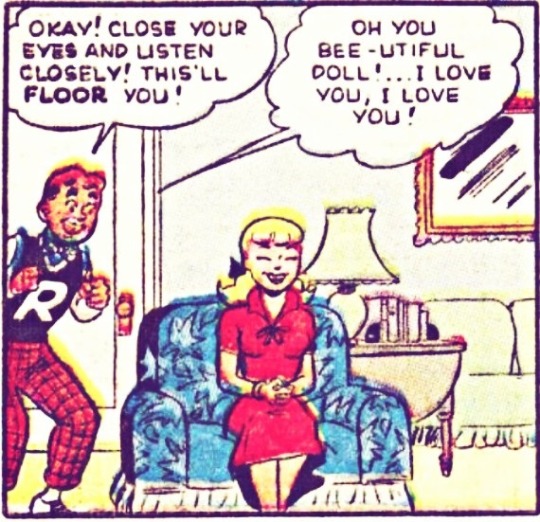

From “Cagey Capers” (1953. Archie’s Girls Betty and Veronica Annual #1)
24 notes
·
View notes
Text
Chadwick Reese | What about the Middle Man? The Impact of Middle Level Managers on Organizational Learning
Chadwick Reese1 & Dr. Debra Hunter2
Abstract
Researchers have explored the relationship between upper echelon leadership and organizational learning in certain settings, namely growth and consistency (Reese, 2006). Researchers continue to explore the various relationships between upper echelon leaders or top management teams (TMT) and organizational learning because the TMT are the people responsible for the allocation of resources and creating a culture that promotes employee training, employee development, teambuilding, and employee advancement. This research proposes a qualitative study in the health care and transportation fields of mid-level managers. The authors seek to understand what was communicated to mid-level managers during a time of change, how that impacted their attitudes, and in turn, what if any individual learning they gained during the time of change. We also seek to identify specific learning that the individual was able to share with their teams within the non- top management teams, and whether they observed those learning being put into policy by upper management. We conclude the perception of middle managers on improving organizational learning is vital to the overall concept
Introduction and Literature Review
Scholars and practitioners continue to argue that organizational learning is the only sustainable competitive advantage that a firm possesses. Researchers have explored the relationship between upper echelon leadership and organizational learning in certain settings, namely growth and consistency (Reese, 2006). Researchers continue to explore the various relationships between upper echelon leaders or top management teams (TMT) and organizational learning because the TMT are the people responsible for the allocation of resources and creating a culture that promotes employee training, employee development, teambuilding, and employee advancement. Further, researchers have examined the process by which strategic decisions are made (Papadakis & Barwise, 1998). These researchers assume that strategic leadership is comprised of top management or upper echelon leaders. Scholars suggest that organizational learning is a key component for firms hoping to create a sustainable competitive advantage.
However, many fail to understand the role they play in setting the standard for the organization (Hambrick, Humphrey, & Gupta, 2013). Prior to Crossan and Hulland. (Bontis, Crossan, & Hullund, 2002) TMT and organizational learning were disconnected fields of inquiry. Following their research, an opportunity still exists to understand how strategy actively manages learning to make adjustments moving forward (Crossan & Berdrow, 2003), further demonstrating how strategic management theory and organizational learning remain disconnected. Given that strategic management involves deploying strategies that enable a firm to remain competitive (Porter, 1998; Teece, 2000), it would be interesting to know how strategic management theory could use the outcomes of organizational learning concepts to actively make adjustments when defining and redefining a firm’s position, specifically how these interactions take place below the TMT (Tsoukas, 1996).
1 Troy University, Troy, Alabama 36082, USA. 2 Troy University, Troy, Alabama 36082, USA.
18 Journal of Management Policies and Practices, Vol. 4(1), June 2016
Some studies have focused on the impact of TMT composition and related resource deployment on firm performance (Carpenter, Geletkancz, & Sanders, 2004), while others have explored individual learning impact on organizational learning (García-Morales, Lloréns-Montes, & Verdú-Jover, 2007) and made loose connections to how negative learning that can stifle strategic implementation (Bednall, Sanders, & Runhaar, 2014; Elenkov, Judge, & Wright, 2005; Narayanan, Zane, & Kemmerer, 2011). What appears to be a gap, and has been called out by other researchers, is exploring the link between the individual aspects related to organizational learning, and how those interplay as both antecedent and result of strategic management (Hutzschenreuter, 2006). All this research builds on the well-established concept that organizational learning occurs at three distinct organizational levels, the individual level, the workgroup level, and the overall organization level, that there are seven dimensions to organizational learning, and that organizational learning can be measured (V J Marsick& Watkins, 1996; V. J. Marsick, 2013; Watkins &Marsick, 1993a, 1993b). In all that contextualization, how middle management interacts with strategic change is absent.
Other research establishes the link between how leadership creates a climate that can foster individual and organizational learning (Berson, Nemanich, Waldman, Galvin, & Keller, 2006), and how that learning can evolve over a period of time in both positive and negative ways (Berends & Lammers, 2010). The link to how firms can use external knowledge to renew strategies, and that internal organizational learning is important to long-range planning has also been established (Jones & Macpherson, 2006), but related research shows that during times where innovation demands requires flexibility between exploration and exploitation, the application of organizational learning to strategic management is inconsistent (Rosing, Frese, & Bausch, 2011).

Studies to understand the nature of changing demands on organizational learning and strategic management are largely focused on external pressures like changes in business climate or merger and acquisition (Narayanan et al., 2011; OReilly, 2013; Shi, Sun, & Prescott, 2012). Research that has worked to understand how individual and team level learning translates into organizational learning have identified what conditions make that translation possible (Hülsheger, Anderson, & Salgado, 2009), but where efforts have been made to understand how that is in turn translated into actionable strategy it has been focused on team-level perceptions that prevent implementation (Huy, 2011). Much of this research points to the same opportunity. Changes in leadership behavior can cause changes in learning climate, but do internal changes in strategy trigger changes in leadership behavior, and how does individual level and organizational learning flow among non TMT team members to impact future strategy (Jansen, Vera, & Crossan, 2009).
Conceptualization
To sum up prior research, the notion that TMT strategic implementation creates an environment, which can be either positive or negative for individual and organizational learning, is undisputed. What hasn’t been explored is how a changing management strategy impacts organizational learning during that time of transition. In the perception of middle management, what constitutes transition, and how does that impact their learning and whether that flows into organizational learning. Strategic management is certainly an antecedent to organizational learning, but how does it affect middle management during times of change? How do those perceptions positively or negatively impact using learning during times of change to adjust TMT strategy?
The authors seek to understand that while the TMT may allocate resources and sponsor an organizational environment that promotes organizational learning, does that commitment flow to lower levels of the organization in time of uncertainty or great change? Are employees more concerned about their own personal well being rather than the well being of the firm? If so, how, and why? If the research were extended, could we predict use of individual learning on long range planning (King, 1983), predicting innovation climate (George, Mcgahan, & Prabhu, 2012) or a host of strategic concepts (Porter, 1980, 1996, 2008). Further, the authors seek to understand whether organizational learning occurs, or why it does not occur, as perceived by non-top management team members in these organizations in time of uncertainty.
Reese & Hunter 19
The researchers explore the questions, if organizational learning does occur, at what level and to what degree? It is important the firms understand the impact on employees during times of uncertainty or change in order to develop a better understanding of potential strategies to employee to continue organizational learning.
We are proposing a qualitative study in the health care and transportation fields of mid-level managers. The research seeks to understand what was communicated to mid-level managers during a time of change, how that impacted their attitudes, and in turn what if any individual learning they gained during the time of change. It also seeks to identify specific learning that the individual was able to share with their teams within the non-top management teams, and whether they observed those learning being put into policy by upper management. Further, it seeks to understand whether the mid-level managers saw learning during a time of change implemented in any quantifiable way. Could they see specific feedback used by the TMT to implement specific policies or processes that improved the organization?
Research Methods
The population for this study will consist of small and medium firms, which carry a high percentage of turnovers. Focusing on the healthcare industry and transportation specifically due to high levels of turnover caused by frequently changing environment. Much of this change takes place at the hands of technological advancements, government regulation, and fiduciary budget constraints. Choosing a sample of firms located across the southeastern region of the United States with a similar cultural, legal and political structure allows us to analyze and identify trends while controlling for variables that may be present within other geographic areas.
Drawing upon our current knowledge of the theory of learning, we can build upon the current model of Top Management Teams creates the strategic plan which creates learning climate, which foster individual learning. We will be focusing on middle managers as our informants, since they carry the responsibility of receiving directive from the TMT as organizational transitions occur. Mid level, managers are also charged with the task disseminating new knowledge to groups and provide supervision that facilitates individual learning. With this hands on interaction mid level can accurately assess organizational learning during periods of uncertainty better than any other level of management.
Chadwick Reese
To probe into middle management view of learning we designed a semi-structured questionnaire to investigate how change initiated by the TMT is received and validated by mid-level manager who must then implement the process to subordinates. If middle management perceives the change as “valid change” versus “invalid forced change” are they able utilize previous individual learning? If middle management perceives the change as “invalid forced change” does the state of uncertainty and pushed effect of TMT create a state of flux, which suppresses organizational learning?
Face-to-Face interviews were conducted with mid level managers. Managers were asked to participate in the study voluntarily. All responses were kept completely confidential and our analysis was a representative of the entire sample not individualistic. We conducted six (6) mid level managers as our sample to explore organizational learning. The interview consisted of structured and open-ended questions. The interviews took approximately thirty to forty- five minutes. At the completion of the interview/ data gathering stage, we analyzed the information for trends and use statistical data if needed. The sample interview guide is outlined below in Table 1. The introductory questions focused on the six major areas identified above are part of our study in Organizational Learning which includes’ the following areas; 1) Communication; 2) Learning; 3) Organizational Support; 4) Access; 5) Change Process and 6) Current business environment. The current business environment is the catalyst of the study given that the study is centered on an uncertain business environment.
20 Journal of Management Policies and Practices, Vol. 4(1), June 2016
Interview Question Guide
Introductory Questions:
1. How long have you been with the company? 2. How long have you been a mid level manager? 3. Where you promoted from within or hired outside the company to become a manager? 4. How is your relationship with the TMT? 5. How do you feel about the stability of the company?
Organizational learning:
1. Has the company made changes to leverage technology and implement systems that are more efficient? 2. Do you feel the company has enhanced the skill set of its employees? 3. Does this new knowledge make employees better equipped to thrive during periods of change and uncertainty 4. Would you classify the company as a learning company; constantly continuing education for development?
5. When faced with situations where you struggle to make a decision, who do consult or seek advice from. 6. Do you rely more heavily upon peer support or TMT members when implementing changes?
During the last 3 years:
a. During a period of uncertainty or drastic change, do you feel you acquired new knowledge to increase individual learning? How so?
b. Do you think you are better equipped to implement what you’ve learned during future periods of uncertainty? If yes, even during periods of forced changed by the TMT that one may feel is pointless?
c. Did learning as you went through uncertainty reduce future uncertainty for you?
Table 1: Sample Interview Guide
The researchers promoted the participants to go into greater detail beyond the sample questions. This allowed the participants to elaborate on their responses, allowing the researchers to gain a better understanding of their perceptions as part of this study. Further, this process of facilitating this discussion allowed the researchers to better triangulate the data and gain a deeper understanding of what drives the phenomena discovered as part of the study.
Data Analysis
As part of the analysis of qualitative research, the issues of validity and must be addressed. In order to improve the validity, the researchers used multiple data sources as part of the project. The idea this that by using the multiple data sources, we would be able to address research weakness involved in using a single method, thus having different researchers and different participants would ensure a more robust and comprehensive study.
A number of the themes raised as part of this study were consistent with what the researchers expected. The most common themes and responses centered on the different avenues and opportunities to learn during time of uncertainty. The results suggest that there is guided learning for middle manager, both actively, and informal communications that occur on a day-to-day basis during the course of the change and uncertainly. The basic concept is that more learning occurred in the paradigm of coaching and soft learning opportunities.
Reese & Hunter 21
The concept of coaching or soft learning was the primary method of learning and dialogue during a state of uncertainty. The researchers were able to identify that middle managers that this form of learning was more important and more effective that formal structured learning given by the company. Additionally, the perception was that the TMT was able to get a better understanding of the middle managers’ concerns and priorities in moving the organization forward. Further, the middle managers were motivated to learn more and take on additional ownership during times of uncertainty. "I'm going to personally learn to do this thing because that change recently hurt. And I'm going to try to make it better the next time."
The researchers also identified the phenomena of proactive learning that occurred among the middle managers, although it was a little less common of a response. One individual stated ".... I sense something strange on the horizon; therefore I'm personally going to go equip myself to handle it..." And typically those respondents were the ones who were able vocalize personal learning more specifically. The participants who were able to recognize uncertainty change on the horizon were better equipped for the change. The researchers identified this as important and separated in the answers for more probing and insight to distinguish between the phenomena of proactive personal learning and reactive personal learning. What remains outstanding is the understanding of relationship that middle managers have of TMT based upon whether they can be classified as proactive or reactive learners.
Formal or structured training tended to favor middle manager in certain positions or who were recent promotions and recent hires compared tenured manager that preferred coaching or soft learning. The researchers failed to correlate formal training based on need, but to the availability of training being offered. Thus, the managers tended to take the training because it was being offend in lieu of understanding the current business environment. Therefore, the four learning modes tended to cluster together in terms of guided learning, learning company, personal learning, and pro-active learning as identified in Figure 1 below.
Figure 1: Mid-level Manager Effect
Communication as identified in Figure 2 tended to group into one or two categories. The two categories were either access the top management team and limited or access to the top management team. The negative aspect of communication very rarely had anything to do with communication was wrong, it simply had to do with communication is absent - either it was existed or was non-existent. In some cases top management teams did not grant access or were not visible to mid level managers. In these cases, it was not an instance was learning did not occur rather the mid-level manager’s created learning opportunities. However, how closely correlated the relationship of this training was to overall organizational strategy was not explored. In the case the mid-level managers provide direction and learning opportunities to front line employees without good transparency to the top management teams.
22 Journal of Management Policies and Practices, Vol. 4(1), June 2016
Figure 2: Communications
The next area we explored was that of stability and change management. The responses suggest that there was a great deal of TMT support during times of change and uncertainty. The participants suggest that the TMT became actively involved in how their job became more complicated, and advanced the idea that did middle managers begin to take proactive steps only to create support for the change.
Figure 3: Stability and Change Management
There researchers were able toto connect and get a perception of support in addition to reality of support as well as access to TMT. While this may seem redundant to the communication aspect but it implies a couple of other issues such as an “open door policy” and “trust” within the company. Mid- level managers had created such a communication channel that lower level would have permission to bypass their lead supervisor if necessary in order to gain clarity.
Figure 4: Access
As indicated in above the concert of the “open door” policy was introduced. It relates directly to the next theme we discovered as indicated in Figure 4 above, access to TMT. Access is was also defined as a degree of transparency, top management team positive is the idea that employees felt like the things that were being told by mid management were from somewhere, not simply being created in the middle. Conversely, as indicated previously, TMT’s that denied access or were absent were categorized as negative. Therefore, if there was access and presence, it was deemed as a positive, by contract, limited access and absence was perceived as a negative. It is important that it was not characterized as good or bad, just a positive or negative perception of TMT.
Reese & Hunter 23
Summary and Next Steps
The theory of organizational learning is that there are various dimensions involved the area of organizational learning. Organizational learning takes place at an individual level, it takes place at a group level and it takes place at a system organizational level. There is a great deal of theoretical research that suggests that the organizations are built to learn, and is directly correlated to their creating a sustainable advantage in the business environment. Organizational learning primarily has two outcomes - increase in knowledge performance and increase in financial performance. Increase in financial performance is tied to your short-term plan. Knowledge performance assumes a more long-term approach in terms of creating, a sustainable advantage. Thus, organizational learning helps fill those two voids.
The researchers looked why his concept is important and in relations to top management teams and how top management teams have influence over organizational learning. Given that TMT has control over resources, set the modes and strategies for an organization to perception of how they are perceived is important. We looked at it from the context of the middle management team and their perception of the top management team in terms of allocation of resources, creating environment, creating the structure, creating the culture that will promote organizational learning. We looked at it in terms of the transfer ability. So we looked at multiple organizations and we also looked at it across industries.
There are a number of themes that occurred during the context of this study including while the research showed some promising results. Greater research is required in this area. The researchers work individually to advance the field and theory of organizational learning at the macro and micro level of organizational studies. One of the emerging trends was in the area of trustworthiness. As a result, future researchers should continue the dialogue and discussion of trustworthiness among middle managers and TMT during periods of uncertainty. Specifically, they should seek to address the central question of, what role does mid levels and the individual play in task master during periods of uncertainty. The ability to address this question would be a vital component to both scholars and practitioners, first to add to the theoretical foundation, secondly, it would provide insight to practitioners to consider when seeking addressing the issue of competitiveness in times of uncertainty.
Additionally, future researchers should look to build upon this study to address the issue the issue of middle management trustworthiness and how it may dictate the employee’s willingness to learn during uncertainty. This question will seek to provide insight on the employee’s concern during periods of uncertainly, specifically, whether they are more concerned about their own well being compared to the well being of the organization. Further, the role of organizational learning during this process. If organizations seek to use organizational learning, as a competitive advantage, even during times of uncertainty, is the relationship between organizational learning and competitive advantage somehow mediated or moderated by uncertainty? The researcher would argue that under certain conditions, the relationship between the two variables would be adversely affected.
Finally, future researchers should explore a greater understanding from a macro level of research in organizational studies. The perception of middle managers on what they believe the TMT should do to improve organizational learning is vital to the overall concept of organizational learning. Assuming that as employees acquire new knowledge, what measures could increase transferability for the purpose of improving or gaining a sustainable competitive advantage. Thus, the perception of middle manager on improving organizational learning is vital for an organization’s future success in terms of financial performance and knowledge performance.
While the current study has concluded, the timeline for furthering the study would be a three-to-four month process. Given that, a base has been established in the transportation and healthcare industry. The researchers would bifurcate the study and focus more in-depth in to one industry. Following the initial study, the researcher would work to improve the validity of the study by focusing primarily on issues of transferability between various industries to devising a conceptual model that would undergo greater test. Thus, a mixed methods system of research, first qualitative to develop the theory or understanding of the theory.

24 Journal of Management Policies and Practices, Vol. 4(1), June 2016
The next step would allow for a larger scale quantitative study. This would allow the researchers to increase the number of participants to understand the relationships generated during the qualitative analysis.
Bibliography
Bednall, T. C., Sanders, K., & Runhaar, P. (2014). Stimulating Informal Learning Activities Through Perceptions of Performance Appraisal Quality and Human Resource Management System Strength: A Two-Wave Study. Academy of Management Learning & Education, 13(1), 45–61. http://doi.org/10.5465/amle.2012.0162 Berends, H., & Lammers, I. (2010). Explaining Discontinuity in Organizational Learning: A Process Analysis.
Organization Studies, 31(8), 1045–1068. http://doi.org/10.1177/0170840610376140 Berson, Y., Nemanich, L. a., Waldman, D. a., Galvin, B. M., & Keller, R. T. (2006). Leadership and organizational
learning: A multiple levels perspective. Leadership Quarterly, 17(6), 577–594.
http://doi.org/10.1016/j.leaqua.2006.10.003 Bontis, N., Crossan, M., & Hullund, J. (2002). Managing an Organizational Learning System By Aligning Stocks and
Flows of Knowledge. Journal of Management Studies, 39(4), 437–469.
http://doi.org/10.5465/APBPP.1999.27594761 Carpenter, M. a., Geletkancz, M. a., & Sanders, W. G. (2004). Upper echelons research revisited: Antecedents,
elements, and consequences of top management team composition. Journal of Management, 30(6), 749–778. http://doi.org/10.1016/j.jm.2004.06.001 Crossan, M., & Berdrow, I. (2003). Organizational learning and strategic management. Organizational Learning and
Strategic Renewal, 24(11), 1087–1105. Elenkov, D. S., Judge, W., & Wright, P. (2005). Strategic leadership and executive innovation influence: An
international multi-cluster comparative study. Strategic Management Journal, 26(7), 665–682. http://doi.org/10.1002/smj.469 García-Morales, V. J., Lloréns-Montes, F. J., & Verdú-Jover, A. J. (2007). Influence of personal mastery on organizational performance through organizational learning and innovation in large firms and SMEs. Technovation, 27(9), 547–568. http://doi.org/10.1016/j.technovation.2007.02.013 George, G., Mcgahan, A. M., &Prabhu, J. (2012). Innovation for Inclusive Growth: Towards a Theoretical
Framework and a Research Agenda. Journal of Management Studies, 49(4), 661–683.
http://doi.org/10.1111/j.1467-6486.2012.01048.x Hambrick, D. C., Humphrey, S. E., & Gupta, A. (2013). Structural Interdependence within Top Management Teams- A Key Moderator of Upper Echelons Predictions. Strategic Management Journal, 461(February 2014), 12. http://doi.org/10.1002/smj Hülsheger, U. R., Anderson, N., & Salgado, J. F. (2009). Team-level predictors of innovation at work: a comprehensive meta-analysis spanning three decades of research. The Journal of Applied Psychology, 94(5), 1128– 1145. http://doi.org/10.1037/a0015978 Hutzschenreuter, T. (2006). Strategy-Process Research: What Have We Learned and What Is Still to Be Explored.
Journal of Management, 32(5), 673–720. http://doi.org/10.1177/0149206306291485 Huy, Q. N. (2011). How Middle Managers Group-Focus Emotions and Social Identities Influence Strategy
Implementation. Strategic Management Journal, 32(2011), 1387–1410. http://doi.org/10.1002/smj Jansen, J. J. P., Vera, D., & Crossan, M. (2009). Strategic leadership for exploration and exploitation: The moderating
role of environmental dynamism. The Leadership Quarterly, 20(1), 5–18.
http://doi.org/10.1016/j.leaqua.2008.11.008 Jones, O., & Macpherson, A. (2006). Inter-Organizational Learning and Strategic Renewal in SMEs. Extending the 4I
Framework. Long Range Planning, 39(2), 155–175. http://doi.org/10.1016/j.lrp.2005.02.012 King, W. R. (1983). Planning for Strategic Support Systems. Long Range Planning, 16(5). Marsick, V. J. (2013). The Dimensions of a Learning Organization Questionnaire (DLOQ): Introduction to the Special Issue Examining DLOQ Use Over a Decade. Advances in Developing Human Resources, 15(2), 127–132.
http://doi.org/10.1177/1523422313475984 Marsick, V. J., & Watkins, K. E. (1996). In Action: Creating the Learning Organisation. American Society for Training and
Development, Alexandria, VA.
Reese & Hunter 25
Narayanan, V. K., Zane, L. J., & Kemmerer, B. (2011). The Cognitive Perspective in Strategy: An Integrative Review.
Journal of Management, 37(1), 305–351. http://doi.org/10.1177/0149206310383986 OReilly, C. a I. (2013). Organizational Ambidexterity : Past , Present and Future. In
Press, 1–30.
http://doi.org/10.5465/amp.2013.0025 Papadakis, V., & Barwise, P. (1998). STRATEGIC DECISIONS. Porter, M. E. (1980). Competitive strategies. New York. Porter, M. E. (1996). What is Strategy? Harvard Business Review, 74(6), 61–78. http://doi.org/10.1098/rspb.2008.0355 Porter, M. E. (1998). Competitive strategy: Techniques for analyzing industries and competitors author: Michael e.
porter, publisher: Free pres.”. Porter, M. E. (2008). Competitive advantage: Creating and sustaining superior performance. Simon and Schuster. Reese, C. L. (2006). Organizational learning among strategic leaders in an international transportation organization.
Dissertation Abstracts International. Rosing, K., Frese, M., & Bausch, A. (2011). Explaining the heterogeneity of the leadership-innovation relationship:
Ambidextrous leadership. Leadership Quarterly, 22(5), 956–974.
http://doi.org/10.1016/j.leaqua.2011.07.014 Shi, W., Sun, J., & Prescott, J. E. (2012). A Temporal Perspective of Merger and Acquisition and Strategic Alliance
Initiatives: Review and Future Direction. Journal of Management, 38(1), 164–209.
http://doi.org/10.1177/0149206311424942 Teece, D. J. (2000). Strategies for Managing Knowledge Assets: the Role of Firm Structure and Industrial Context.
Long Range Planning, 33(1), 35–54. http://doi.org/10.1016/S0024-6301(99)00117-X Tsoukas, H. (1996). The firm as a distributed knowledge system: A constructionist approach. Strategic Management
Journal, 17, 11–25. Watkins, K. E., & Marsick, V. J. (1993a). Sculpting the learning organization: Lessons in the art and science of systemic change.
ERIC. Watkins, K. E., & Marsick, V. J. (1993b). Sculpting the learning organization: Lessons in the Art and Science of
Systemic Change, 6(4), 421–423. Mouvements, 58(2), 104–116.
0 notes